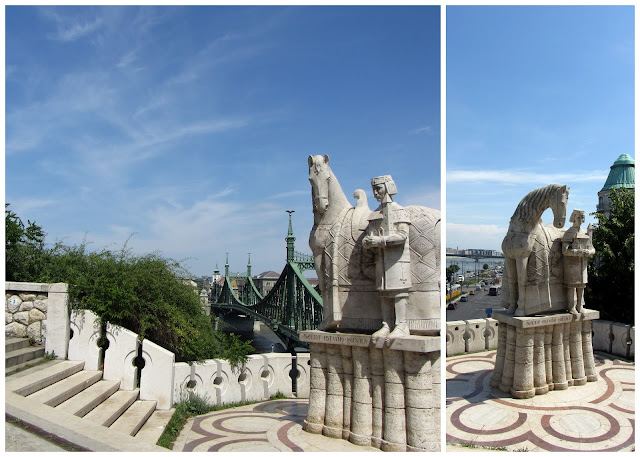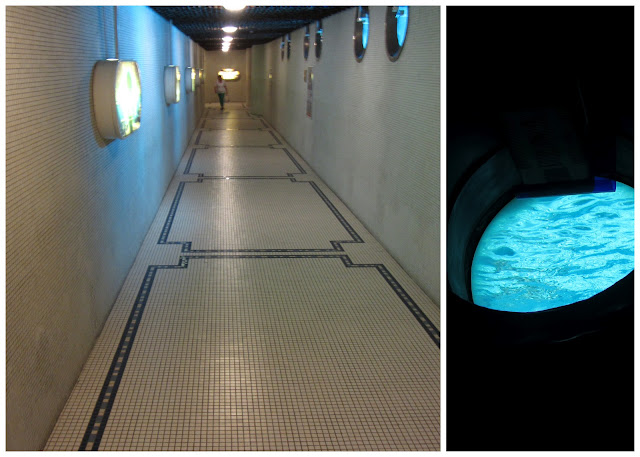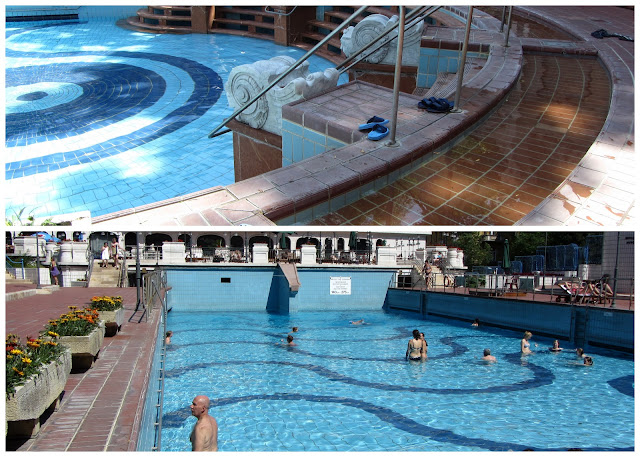For our second day in Budapest, we decided to take a break from the museum hopping to visit someplace we were all really looking forward to: an authentic bathhouse. We had done a project similar to a bathhouse in architecture school last year, so I was definitely excited to see how a real experience would compare to what we had been designing and discussing in first year studio. We set out on our journey in the morning/mid-day, so we had plenty of time to explore a bit and spend a nice couple of hours escaping from school!
Crossing the bridge by foot was a pretty cool experience in itself: there were some really great views of the Danube River and it was nice enough that people were actually picnicing on the bridge itself (as you can see above)!
As we neared the end of the bridge, we began noticing a castle-like building emerging from the rocky hillside that was before us. We drew closer to realize that it was actually a church, so of course when all but one of my friends headed to the bathhouse, I had to go with her to see what was inside. I can easily count how many times I cross this in everyday life (zero) so I was completely curious to venture in.
It didn't quite have the paralleled grandeur that the exterior did, but it was certainly a charming little church that provided enough of a history lesson that I felt I had adequately learned something additional about Budapest that day. The cave was in its first life a source of healing thermal waters, something which St. Istvan, a local monk, took advantage of to heal his neighbors (the statue pictured a few photos above is of St. Istvan and his horse). The cave become St. Istvan's home, and was later re-purposed to serve the spiritual needs of the monk community. It thus became a sort of cave-church, which lasted for about 20 years until the Communist Party arrested all the monks and constructed a thick concrete wall around the church. After the fall of the Communists in the late 1900s, it was returned back to be used again for religious practices.
Next we moved onto the Gellert bathhouse, which was conveniently almost right next door. From the outside even we could tell it was huge, which began to worry us a bit since we had heard rumors that it was a pretty tedious and maze-like process of entering.
But, it was also incredible from the beginning. The main hall had high ceilings with beautifully crafted detail. It was lit by the sun and there were a fair number of people waiting to buy tickets--we were anxious to see the baths.
Walking in definitely was a bit of a labyrinth. We took lots of turns to the point where I was even more disoriented than I normally am. There were a few signs along the way, but again we were in Hungary so it was mostly in Hungarian (: We didn't know it at the time, but this hallway was one of the last we had to walk through before reaching the locker room. It was pretty neat since there were small rounded windows running along the right side, which actually showed underwater views of the pool next door.
Good thing for pictures!
Finally we made it! And it was amazing--there were a lot of little levels, decks, and places where visitors could relax and take in the sun. This show shows the main pool and some of the raised tiers where people were tanning. The main building toward the left is from where we emerged, and also where the indoor pools are located.
This is one of the smaller pools on a higher level, which exists because it is considered a 'warm pool.' I really liked that they had different temperature pools, since I usually am a bit chillier than everyone else!
This is the main pool, which also doubled as a wave pool every half hour or so. I wasn't expecting that to happen, at least not at an ancient bathhouse! It was fun though, that's for sure (:
This is one of my favorite photos because it shows the procession of entering the pool. We had talked a lot about this in architecture school when we were working on our pool project, and it was explained to us by my professor that it is customary to have a small, shallow place to dip your feet in before entering to keep the pool clean. It's just cool to think about all these little things and ways of going about activities that influence an architect's design.
A beautiful day with beautiful flowers and greenery!
There were stairs and that lead up to shaded garden areas with lounging chairs and everything. There were places for every type of pool-goer here to say the least.
You can see more tiers again above
Inside was amazing as well, which admittedly we didn't even enter well until a few hours after arriving (it was just so darn sunny and nice outside!) but once we did, we found it to be just as nicely lit by the sun as outside nearly! There were large sky windows to help with that. The etiquette was different inside as well: swim caps were required, and it was just a bit less playful as people were doing water aerobics, laps, and other things. So the shots above are of that pool.
..and behind the main pool was a smaller, and again, warmer pool that was more used for relaxation. There were large gargoyle-like heads fixated on the sides of the pool that spilled out water at a high pressure, which people in turn stand under to work out kinks in their backs. Soo relaxing!
The last of the pools we had yet to experience were the hot thermal baths, which have yet another set of rules! The thermal baths are split into two private rooms to separate gender, as we soon found out this is because people apparently are allowed to walk around naked or half-naked to their heart's content. Talk about an awkward surprise. Either way, the baths were fairly toasty, and the water was so clear and blue it was remarkable. The ornamental tiling was super pretty, I had never seen anything like it. After staying in the hot thermal bath for as long as we could stand, we found a spout in the wall pouring ice-cold water into something which resembled a bird bath. Thank goodness. It felt amazing.
There were showers in the thermal pool section as well, showing off the brilliant tile work I mentioned!
Another neat contraption we stumbled upon on our way out: adjustable hair dryers! I started passing these a bit slowly trying to figure out what these were, and once we figured it out I thought they were a clever little invention.
Along the way home, we passed the Parliament building once more and finally arrived at the market/train station to take us back to the hotel.
And then, it was back to the busy restaurant row around the corner for dinner. I figured my luck had expired with all of the great things I had whimsically come across earlier in Budapest, and I was nearly right. I wound up splitting just an average chicken/potato dinner with a friend, but it was in Budapest so what did I care?! The three of us wound up splitting dessert too, so that doesn't make for a bad touch either (: Also a fun little note about the menu: look at how peanut butter is listed. Always fun to come across little strange English translations throughout this trip!
All said and done: a very cool day. It was extremely intriguing to witness and play a part in a place that has its own little set of customs, rules, regulations, and general way of going about things. Even more exciting was the chance to have designed such a seemingly bizarre and foreign function and program, and then see how a successful one actually operates in reality. It's always neat to have studied something for an extended period of time, and then have the chance to see it afterward.
Cheers and happy Independence Day!










































No comments:
Post a Comment